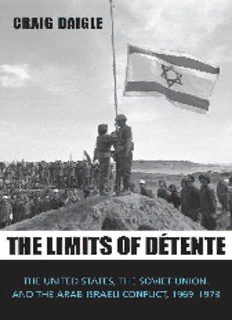
The Limits of Detente: The United States, the Soviet Union, and the Arab-Israeli Conflict, 1969-1973 PDF
Preview The Limits of Detente: The United States, the Soviet Union, and the Arab-Israeli Conflict, 1969-1973
the limits of détente This page intentionally left blank The Limits of Détente The United States, the Soviet Union, and 1969 1973 the Arab-Israeli Conflict, – c r a i g d a i g l e n e w h a v e n a n d l o n d o n Copyright © 2012 by Yale University. All rights reserved. This book may not be reproduced, in whole or in part, including illustrations, in any form (beyond that copying permitted by Sections 107 and 108 of the US Copyright Law and except by reviewers for the public press), without written permission from the publishers. Yale University Press books may be purchased in quantity for educational, business, or promotional use. For information, please e-mail [email protected] (US office) or [email protected] (UK office). Set in Electra type by IDS Infotech, Ltd. Printed in the United States of America. Library of Congress Cataloging-in-Publication Data Daigle, Craig. The limits of détente : the United States, the Soviet Union, and the Arab-Israeli conflict, 1969–1973 / Craig Daigle. p. cm. Includes bibliographical references and index. ISBN 978–0–300–16713–9 (clothbound : alk. paper) 1. Middle East—Foreign relations—United States. 2. United States—Foreign relations—Middle East.3. United States—Foreign relations—Soviet Union. 4. Soviet Union—Foreign relations— United States. 5. Cold War. 6. Arab-Israeli conflict. I. Title. DS63.2.U5D34 2012 956.04—dc23 2012016446 A catalogue record for this book is available from the British Library. This paper meets the requirements of ANSI/NISO Z39.48–1992 (Permanence of Paper). 10 9 8 7 6 5 4 3 2 1 For Jack Benson and Fred Engel This page intentionally left blank contents Acknowledgments ix List of Abbreviations xv Introduction 1 one From Confrontation to Negotiation, January–September 1969 10 two The Rogers Plan, October–December1969 48 three The First Soviet Threat, January–May 1970 83 four Crisis on the Suez, June–September 1970 113 contents five Fighting for Sadat, October1970–August 1971 155 six The Race to the Summit, September1971–May1972 192 seven Bombshells and Back Channels, June 1972–February 1973 228 eight The Contradictions of Leonid Brezhnev, March–October1973 261 nine The Crisis of Détente, October1973 294 Conclusion 332 Notes 347 Index 403 viii acknowledgments The notion that I would ever write a book remains a somewhat foreign concept to me. Not that long ago it seems that I was getting kicked out of classes in middle and high school for poor behavior, struggling to get into college, and scoring below 400 on the verbal portion of graduate admissions exams (yes, it’s possible). Thus, countless number of teachers, colleagues, friends, and family members have helped get me to this point and deserve mention for their role in helping produce this book. My interest in the history of American foreign relations dates from my undergraduate studies at the University of Maryland, where I benefited from the guidance of Professor Shu Guang Zhang. Not only did Professor Zhang broaden my understanding of the US role in the world and the con- nection between American foreign and domestic policies, but he taught me important and valuable historical methodical techniques without which I could not have completed this book. It was also at Maryland that I had the great fortune to have Matt Wasniewski, now the Historian of the House of Representatives, as my graduate teaching instructor. I thank Matt for help- ing me develop needed skills as a researcher and a writer and for insisting that I become a more focused and engaged reader. I am also profoundly indebted to Matt for encouraging me to pursue my graduate studies at his alma mater, James Madison University—the best decision I made in my many years of education. The two years I spent as a graduate student in history at JMU were invalu- able in teaching me the craft of becoming a professional historian and for ix
Description: